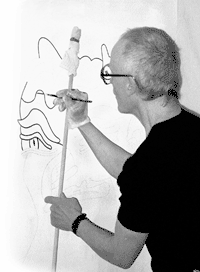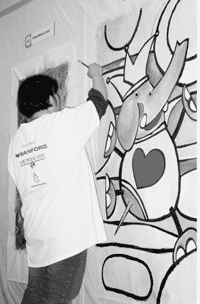By Maureen Murphy
 If
you think that the combination of wet paint and the expensive black clothes
favored by society’s elite is a bad idea, the organizers of BareWalls
would disagree. Bare-Walls, the annual fundraiser that has raked in thousands
of dollars for SAIC student scholarships for eight years, brings dozens
of SAIC alumni to Gallery 2 to paint three-foot by five-foot pieces of
canvas that patrons bid on while they observe the artists create their
work. This year, $80,000 was raised and about 850 patrons attended. If
you think that the combination of wet paint and the expensive black clothes
favored by society’s elite is a bad idea, the organizers of BareWalls
would disagree. Bare-Walls, the annual fundraiser that has raked in thousands
of dollars for SAIC student scholarships for eight years, brings dozens
of SAIC alumni to Gallery 2 to paint three-foot by five-foot pieces of
canvas that patrons bid on while they observe the artists create their
work. This year, $80,000 was raised and about 850 patrons attended.
In addition to bringing in scholarship money, BareWalls (which is non-juried,
thus representing the diversity of SAIC’s alumni) succeeds in many
ways. The fundraiser is an opportunity to bring together over 150 alumni
to one location. And this location isn’t unimportant, either. Hosting
the fundraiser at Gallery 2 brings both alumni and potential bidders to
a student space, rather than the usually roped off 112 S. Michigan ballroom
or the intimidating AIC auditoriums. And, of course, the fundraiser assures
current students that there are alumni who are indeed active in the world
of art, and are still considered a part of the SAIC community after graduation.
BareWalls also provides an opportunity for students who have 50 bucks
to shell out or receive comp passes (like me) to talk to alumni. Many
of the alumni whom I talked to fondly remembered the diversity of ideas
present at SAIC. Barry Surkis, who received his BFA in 1975, said he was
really lucky to have classes with artists like Robert Smithson and Stan
Brakhage, and Claes Oldenberg was a visiting artist at the time. Now a
teacher at North Central College, Surkis added, “Of course the faculty
[at SAIC] was exceptional.”
Another facet of SAIC that alumni praised is the emphasis on working within
many disciplines. 2001 graduate Lisa French, who now works at the Gene
Siskel Film Center, said that one of her favorite aspects of the school
was “definitely trying different media.” 
George C. Clark, who received his BFA in 1965, said “They made everybody
take a curriculum that covered the whole range of arts. By exposing you
to all those things they open your eyes to [that which] you would not
have discovered for yourself.” Clark, who emphasized in design and
printmaking while at SAIC, has been working mostly in advertising and
illustrating, in addition to showing his work in galleries.
Another common sentiment was the amount of fun
the alumni had while at SAIC. Alum Kris Cahill, who studied fashion and
textile design and received her BFA in 1982, returned to SAIC in 1989
to develop her painting skills. According to Cahill, “It was a blast,
it was so fun ... I was there at the age of 17 ... I made great friends.”
Cahill, whose education has led her to design costumes for dance and opera
productions, and is also a meditation instructor, did find some challenges
at SAIC. She commented, “I have my issues with competition and critiques
... which I hate.”
Although many alumni interviewed were teachers
and working in the arts, Atyl’s (who goes by one name) education
at SAIC led her to an unlikely career in law. After graduating in 1999,
Atyl worked as an interior designer. But, she says, “after a while it was obvious that [people] try to
rip off artists through intellectual property issues, so I decided to
do something about that.” She is now a lawyer who represents artists.
But, she says, “after a while it was obvious that [people] try to
rip off artists through intellectual property issues, so I decided to
do something about that.” She is now a lawyer who represents artists.
A few alumni found the job market to be rough. Amy Defries’ painting,
featuring an office break room-style coffeemaker bubbling over accompanied
by the text, “There’s Trouble Brewing!”, can easily
be related to the stiff job market and Enron-style corporate drama. After
receiving a BFA in 1991, Defries started her own business to pay off her
debt. Although Defries said, “I’m still up to my ears in student
loans,” she doesn’t seem to regret going to school at SAIC.
She added, “I don’t have to be anyone’s slave ... I
have a stress-free existence. I’m not in it for the money, although
it would be nice. ... My true wealth is my education.”
C. Maura Poshka, who received her BFA in 1974 and Master’s in Art
Therapy in 1992, has found the demand for art therapy to be very slim.
However, she says, “Although I’m not a famous person ... I’m
still a strong product of the Art Institute.”
Photographs by Maureen Murphy
|

